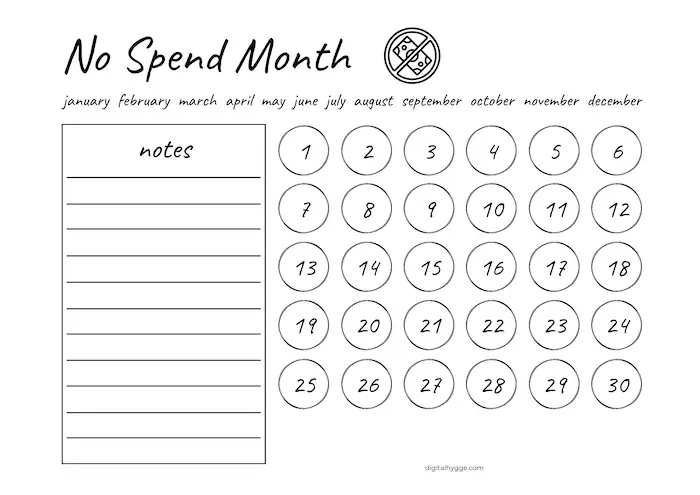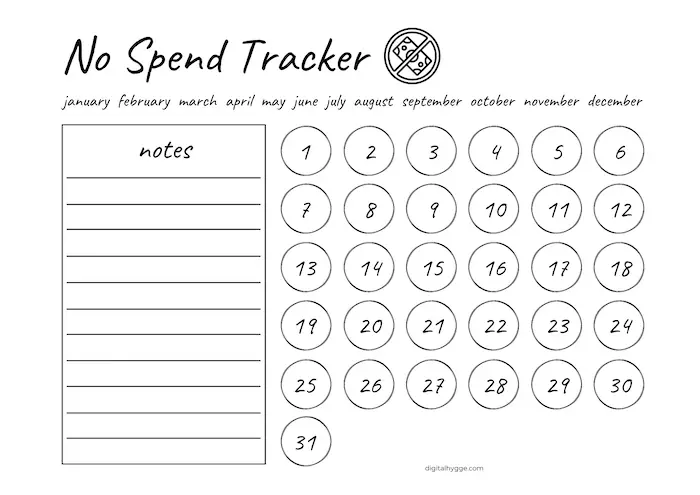The ‘no spend challenge‘ isn’t a new concept, but it’s recently seen a revival, particularly among the younger generation on social media platforms like TikTok and Instagram. With hashtags like #nospendjanuary and #nospendchallenge gaining millions of views, it’s evident that this approach is resonating with many.
People are embracing the no buy challenge as a creative and empowering way to rethink their spending habits and find joy in simplicity, all while navigating the realities of today’s economic landscape with a sense of optimism and resilience.
No Spend Challenge Guide
↓ Click on these quick links to go straight to a section, or scroll down to read the whole article.
Meaning | Rules | Length | No Spend Trackers | How-To Guide | Tips
What is a No-Spend Challenge?
No-spend challenge is a simple yet efficient way to save money and reset your financial priorities. By consciously deciding not to spend on non-essentials, you gain valuable insights into your spending patterns and learn how to appreciate and make the most of what you already have.
The No-Spend Challenge Rules
The no-spend challenge rules are very straightforward. The primary aim is to identify and temporarily cut out non-essential expenses. Focus on just the essentials like rent, utilities, and groceries, while putting all extras on hold.
This means pausing expenditures on anything from dining out and impulsive shopping to luxury services and monthly subscriptions, such as Netflix. It might also involve skipping the daily coffee shop run or delaying the purchase of the latest smartphone model.
The no-spend challenge serves as an opportunity to transform your spending habits. It offers a clear view of where your money is spent and can lead to significant savings as a beneficial byproduct.
The No-Spend Challenge Length
January, a.k.a. ‘no spend January‘, often marks the start of the no-spend challenge for many, acting as a financial detox after the holiday season’s expenses. It’s a time for new beginnings and setting positive financial intentions for the year. However, the beauty of this challenge is that it’s not bound to any specific time; you can start whenever you feel ready.
Choosing a Duration That Suits You
The most popular duration for a no-spend challenge is typically one month, often referred to as “no-spend month“. However, the length of the challenge can vary greatly based on your personal goals, ranging from as short as one week to as long as a year.
If you’re seeking a more substantial test, you might want to consider a ‘no spend year‘. This extended period poses a greater challenge but can significantly deepen your understanding of personal finance and lead to more substantial savings.
Ultimately, the duration of your no-spend challenge should be tailored to your individual goals and lifestyle. Whether you opt for a week, a month, 90 days or the whole year, or any period in between, what’s most important is choosing a timeframe that aligns with your financial aspirations and daily life.
Track Your Progress with a No-Spend Tracker
One of the most effective ways to stay committed to your no-spend challenge is by visually tracking your progress. It’s not just about marking off days; it’s about seeing your journey unfold. This can be incredibly motivating and helps you stay focused on your goals.
I’ve created a vast collection of printable no-spend trackers, all available for you to download absolutely free. Below is a sneak peek of what’s in store. For even more options, feel free to visit the dedicated no-spend trackers page.

Download: A4 size | Letter size

Download: A4 size | Letter size
How to Do a No-Spend Challenge
Here are a few tips for you.
1. Set Your No-Spend Challenge Goal
First things first: what’s your aim with the no-spend challenge?
A clear, concrete goal is crucial. It could be saving up for that dream vacation, paying off debt, or building a financial safety net. Perhaps your aim is more introspective; you might want to reassess your spending habits, recognizing that saving money will be a beneficial side effect of the challenge.
For some, the challenge is about breaking the cycle of impulsive purchases and fostering a more conscious, deliberate approach to spending. It’s not just about putting money aside; it’s about evolving your relationship with money and consumption. Whether it’s adopting a more minimalist lifestyle, being more environmentally conscious, or just gaining a clearer understanding of your financial priorities, your goal will guide and motivate you throughout the no-spend challenge.
2. Establish the Rules for YOUR No-Spend Challenge
Now, it’s time to get personal with your challenge. Think about your daily life: what are the things you absolutely need, and what are the items you can do without? This isn’t just about broad categories like ‘food’ or ‘clothes’ but about the specifics. For example, groceries are a need, but do you need to buy that expensive brand or could a more economical choice suffice?
Needs vs. Wants: The Fine Line
Distinguishing between ‘needs’ and ‘wants’ can be tricky, but it’s crucial for the success of your challenge. A need is something essential for your basic living – rent, utilities, basic groceries, essential transportation. Wants, however, are those things that make life more enjoyable but are not essential. That daily coffee from the cafe, the streaming service subscription, or the weekend takeout might fall into this category.
Setting Achievable Boundaries
Be realistic in setting these rules. They should be challenging enough to push you out of your comfort zone but not so strict that they set you up for failure. For example, if you know you can’t function without your morning coffee, consider brewing it at home rather than cutting it out completely.
Remember, your no-spend challenge is unique to you. Your friend’s rules might look completely different, and that’s okay. Maybe your challenge includes cutting out online shopping, reducing dining out to once a month, or using public transportation more often instead of driving. Tailor the challenge to fit your lifestyle and goals.
3. Celebrate Your Victories
Remember, every no-spend day is an achievement worth celebrating. Tracking your progress allows you to see how far you’ve come and keeps you motivated. It’s about acknowledging your discipline and commitment, and these small celebrations can be a powerful tool in maintaining your momentum throughout the challenge.
I’m working on adding some awesome tips and creative ideas on how to treat yourself without breaking the bank. After all, finding ways to reward yourself that don’t counter the spirit of the no-spend challenge is what it’s all about. Stay tuned for some fun and budget-friendly reward ideas coming your way soon!
3 Tips for Success in the No-Spend Challenge
Remember that the no-spend challenge isn’t just about temporary cuts; it’s an opportunity to forge sustainable changes in your spending habits. Reflect on your relationship with money and consider how you can maintain these healthier habits beyond the challenge.
- Smart Savings: As you save money, think about where to put it. Whether it’s into budgeting envelopes, a savings account, or a trusty tin jar, make sure your saved money has a purpose or a place to grow.
- Beware of Revenge Spending: Be cautious of the urge to ‘revenge spend’ once the challenge is over. The key is to create lasting, sustainable financial habits, not just a temporary spending freeze.
- Community Support: Don’t go it alone. Sharing your journey with friends, family, or an online community can provide a support system, motivation, and accountability.
Why Try a No Spend Challenge?
Remember, the true power of the no buy challenge lies in the long-term financial habits you develop. It’s about more than just temporary savings; it’s about cultivating a mindful approach to spending and making sustainable changes in your financial lifestyle. So why not give it a shot? You might just surprise yourself with how much you can accomplish. Embrace the challenge – your wallet and future self will thank you!
Keep Reading:




